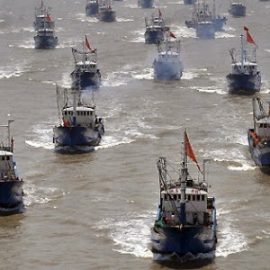While Russian “volunteers,” such as those who inexplicably showed up in Crimea in 2014, without insignia and with full Russian Army gear and weapons, are known as “Little Green Men,” the Chinese have their own equivalent at sea. Sometimes called “Little Blue Men,” the People’s Armed Forces Maritime Militia have come to provide a “Gray Zone” force multiplier for the People’s Liberation Army Navy (PLAN) in the contested areas of the Western Pacific. The backbone of Communist Chinese maritime force has long been the maritime militias, largely out of necessity. The PLAN was hardly a force to be reckoned with in the late ’40s and onward. Much of the PRC’s coastal defense was militia, in keeping with Mao’s emphasis on guerrilla warfare. However, in recent years, with some pointing to Xi Jinping’s visit to the Tanmen Militia in 2013 as an impetus, the PAFMM has become more of a force projection instrument, particularly based around Hainan, Guangdong, and Guangxi. Divided into “primary” and “reserve” units, the maritime militia isn’t as equipped as the PLAN, but it is expected to do a great deal, particularly in the South China Sea. Since the PRC claims a number of islands in the Spratly and
The South China Sea and Tensions With China
While Russia has taken front and center attention recently, due to the use of Russian agitprop to influence the internal affairs of Russia’s chief strategic rival (i.e., us), Russia is not the only major power that sees the US as a rival in its regional and global strategic goals. (Strangely, most of the outrage over Russia right now seems to be focused on their information and influence operations, rather than the continuing frozen conflicts in Ukraine, Transnistria, Nagorno-Kharabakh, and South Ossetia, to name only a few. But that’s another matter for another post.) China, in addition to conducting quiet resource-gathering operations worldwide, with a pronounced tendency not to care what kind of criminals they’re doing business with (see: shipping illegally mined iron ore out of the port of Lazaro-Cardenas in Mexico while that port was under control of the Caballeros Templarios cartel), has been expanding its regional military power projection, mostly focused on the South China Sea. Not only do several major shipping lanes pass through the South China Sea, making control of the waters there strategically important for reasons of power projection, but the two primary disputed island chains, the Paracels and the Spratlys, are thought to contain oil
“Kill Yuan” Is Now Available
Today’s the day. Kill Yuan is out. Amazon’s being a little slower getting the paperback up than they have previously, but it is on the way. The Kindle link is here. As previously announced, the ebook is presently Kindle exclusive. I’m giving Kindle Select a try, which also means that if you are subscribed to Kindle Unlimited, you can borrow the book on your Kindle. Signed paperbacks are now available for pre-order on americanpraetorians.com, to go out June 10.
China Keeps Pushing
China has been a player in a couple of my novels, now. The Devil You Don’t Know dealt in part with the PRC’s dealings with Mexican cartels. Kill Yuan is set on the periphery of the perennial flashpoint of the South China Sea. Neither are new, though the South China Sea is becoming more and more of a focus, as China continues to push the US Navy as well as all of their maritime neighbors to the south, including Vietnam, the Philippines, and Malaysia. The Spratlys have been a flashpoint with China’s neighbors for decades. The Chinese claim actually, according to Beijing and Taipei (which claims the islands under the auspices of the Nationalist Chinese government that preceded Mao’s Red China), dates back to the Han Dynasty, in 2 BC. Malaysia, Brunei, Vietnam, and the Philippines also claim the islands. In recent years, the PRC has begun building up reefs in the South China Sea into artificial islands, claiming that these are for scientific research such as fish population studies, though, in spite of the conspicuous operation of civilian airliners on the artificial island on Fiery Reef, there appears to be plenty of military equipment on the islands. They have
“Kill Yuan” AO Brief
Since Kill Yuan is set in an AO I haven’t ventured into before, I thought it might be useful to set out a bit of an orientation. The setting is the South China Sea, recently the scene of extensive maritime territorial disputes between China, the Philippines, and Vietnam. Other countries have become peripherally involved (including the US), to include Indonesia and Malaysia. To get a bit of a picture of the overall geography of the disputes, here’s a map: As part of its program of expanded influence, China has not only been expanding its naval presence in the Spratlys and the Paracels, but it has actually been building artificial islands to further cement its claims. A good brief of the overall situation by the BBC is here.
